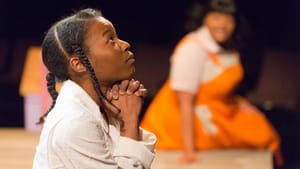Stay in the Loop
BSR publishes on a weekly schedule, with an email newsletter every Wednesday and Thursday morning. There’s no paywall, and subscribing is always free.
"Unflinching" story flinches onstage
Arden Theatre Company presents Lydia R. Diamond's adaptation of Toni Morrison's 'The Bluest Eye'

Arden Theatre Company fittingly opened its production of The Bluest Eye on International Women’s Day. Few works so astutely capture the pain black women have endured for centuries as Toni Morrison’s 1970 literary debut. Unfortunately, Lydia R. Diamond’s arch and sanitized adaptation, seen here under the stylized direction of Raelle Myrick-Hodges, fails to communicate the wrenching power of its source text.
Diamond clearly reveres the sharp but poetic language of Morrison’s novel. She drops entire passages verbatim into the mouths of Claudia (Nicolette Lynch) and Frieda (Renika Williams), who serve as the evening’s de facto narrators. They tell the story of Pecola Breedlove (Jasmine Ward), an unhappy and abused African-American girl who believes her life will change if God grants her beautiful blue eyes.
"Lost in translation"
Although much of Diamond’s language comes directly from Morrison’s pen, it often feels lost in translation. On the page, The Bluest Eye stands as an unflinching examination of many harsh topics, including inter- and intracultural racism, poverty, incest, rape, mental illness, and the societal weight women are expected to bear. These themes are often muted or entirely obscured by discursive directorial and design elements that produce an unwanted distancing effect.
Morrison’s framing device — a Dick and Jane reader that Pecola pores over — becomes the inspiration for David P. Gordon’s imposing set. Dollhouses and cardboard dogs flank the skinny catwalk that serves as the main stage, while the theater’s back wall opens to reveal a massive multistory home. The effect seems designed to show us the multiple levels of wealth that exist within one small Ohio town, from the small shack where Pecola grows up to the grand home on the white side of town where her mother (Chavez Ravine) works as a maid.
Levonne Lindsay’s Brechtian costumes define the characters who wear them — sometimes literally. As the play begins, Frieda and Claudia appear with their names stitched onto their dresses. “Despair” is emblazoned on Mrs. Breedlove’s starched uniform. Maureen Peal (Eliana Fabiyi), described as a “high-yellow dream child” for her light skin and straight hair, wears a skirt that reads “pretty”.
This heavy-handed marriage of literalism and overtheatricalized abstraction undercuts the elliptical and poetic nature of Morrison’s words. Nowhere is this more keenly felt than in the use of a life-sized doll to represent the white daughter of Mrs. Breedlove’s employer.
When Mrs. Breedlove turns away from her own child to comfort the white girl, a moment that should be shattering becomes unintentionally comedic. (It doesn’t help that the doll resembles Patty McCormack in The Bad Seed).
Softening of the edges
Other directorial and dramaturgical decisions are more problematic. Myrick-Hodges and choreographer Antonio Brown present Pecola’s rape and impregnation by her father Cholly (Reggie D. White) as an interpretive dance. The choice both softens and trivializes a graphic, horrific moment that forever scars the little girl. Something as awful as rape should not be reduced to mere stagecraft.
It’s of a piece with how Cholly is presented by Diamond. More than any other character in the play, we are shown his tragic backstory, which tacitly serves to justify how he became the violent, alcoholic, sexually abusive man who commits the barbarous act. No other character — not even Pecola — receives this level of sympathy. Should a story of women lavish such compassion on a predatory man?
Perhaps because of that compassion, White gives the production’s most fully realized performance. Damien J. Wallace is appropriately mercurial as Soaphead Church, the community’s resident “interpreter of dreams,” and Lynch and Williams carry off their narratorial responsibilities well. But in her attempt to project Pecola’s childish innocence, the adult Ward too often grows cloying.
The Bluest Eye ends with Pecola’s descent into madness, as she begins to believe her fervent wish for Caucasian features has come true. It’s also meant to show her community the ways in which they participated in her downfall. “All of our waste we dumped on her and which she absorbed,” Claudia reflects in the novel. “And all of our beauty, which was hers first and which she gave to us.”
The final moment, which should be heartbreaking and gut-wrenching, instead remains abstruse. Pecola looks into a mirror and sees blue eyes where there are none. But the adaptation and production never truly hold up a mirror and force the audience to consider its own complicity.
What, When, Where
The Bluest Eye. Adapted from the novel by Toni Morrison by Lydia R. Diamond, Raelle Myrick-Hodges directed. Through April 1, 2018, at the Arden Theatre Company’s F. Otto Haas Stage, 40 N. Second Street, Philadelphia. (215) 922-1122 or ardentheatre.org.
Sign up for our newsletter
All of the week's new articles, all in one place. Sign up for the free weekly BSR newsletters, and don't miss a conversation.

 Cameron Kelsall
Cameron Kelsall